Wolfram Function Repository
Instant-use add-on functions for the Wolfram Language
Function Repository Resource:
Filter regions based on their overlap
ResourceFunction["NonMaximumSuppression"][{reg1,reg2,…}] keeps the rectangular regions regi with low overlap between each other. | |
ResourceFunction["NonMaximumSuppression"][{reg1,…}→{w1,…}] uses the weights wi to score the importance of each regi. | |
ResourceFunction["NonMaximumSuppression"][regions,property] gives the specified property for the filtered regions. |
| "Index" | position of the selected region |
| "Region" | selected region |
| "Weight" | the weight used to score the region |
| {prop1,…} | a list of properties |
| All | all the available properties |
| AcceptanceThreshold | Automatic | region acceptance threshold |
| MaxOverlapFraction | Automatic | maximum allowed overlap fraction |
| Method | "Hard" | method to use |
| "Hard" | remove regions with overlap greater than the specified threshold |
| "Soft" | iteratively rescore the regions based on their overlap |
Filter out rectangles from list that have a big overlap with other rectangles in the list:
| In[1]:= |
| Out[1]= |
Define and display a list of rectangle shapes:
| In[2]:= | ![SeedRandom[123];
Short[(boxes = Flatten@Array[
Rectangle[2 {##} + RandomVariate[NormalDistribution[], 2], 2 {##} + RandomReal[{3, 9}, 2]] &, {5, 3}])]](https://www.wolframcloud.com/obj/resourcesystem/images/1a4/1a4d3d13-f50c-4ae2-9c5f-860c451341c5/429afc45f5e01c84.png) |
| Out[3]= |
| In[4]:= |
| Out[4]= |  |
Delete rectangles with high overlap and display the results in red along with the original rectangles in black:
| In[5]:= |
| Out[6]= | 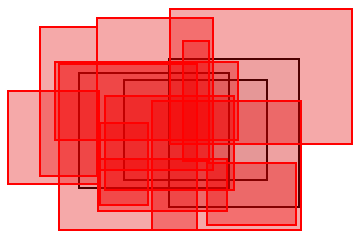 |
Only keep non-overlapping rectangles:
| In[7]:= |
| Out[8]= | 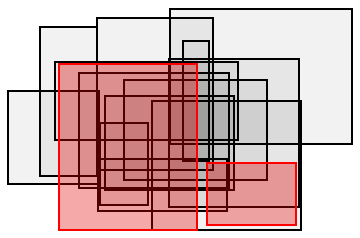 |
Perform non-max suppression on a list of regions:
| In[9]:= |
| Out[10]= |
| In[11]:= |
| Out[11]= |
| In[12]:= |
| Out[12]= | 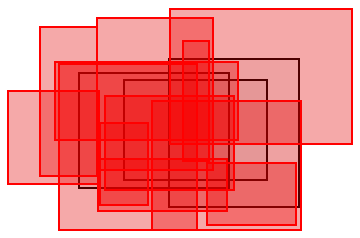 |
Provide an explicit list of weights:
| In[13]:= | ![boxes = {
Rectangle[{3.241549223388991, 1.8258945791733319`}, {
10.659287859633295`, 10.773294493394275`}],
Rectangle[{0.4869914284730348, 4.321183643750274}, {5.369829888721986,
9.31386702637484}],
Rectangle[{2.2334201426158136`, 4.721638979849482}, {
5.291543408030995, 12.769601273219152`}],
Rectangle[{5.349846089859113, 2.8592299264608263`}, {
12.259520398084739`, 5.65464262378527}],
Rectangle[{5.419709227350725, 3.2032779499946393`}, {
8.019495864892848, 7.597470779871912}],
Rectangle[{2.9916342183590716`, 6.701712853508063}, {
12.82951197826295, 10.889573073474823`}],
Rectangle[{5.716124755621678, 4.016397691332317}, {
12.634485498683249`, 9.030579596384047}],
Rectangle[{4.318687518098674, 4.086673071150529}, {
12.377658857900416`, 10.295175285987018`}],
Rectangle[{5.254646844539921, 5.048321499467785}, {
11.505305608427992`, 13.227130047971752`}],
Rectangle[{8.231089286494171, 1.8404075028314466`}, {16.2229662869946,
8.789967125833199}],
Rectangle[{6.7403064092133205`, 4.533063177477215}, {
14.410877169797764`, 9.89745177054213}],
Rectangle[{9.862402933845159, 5.563175394985179}, {
11.276877537331307`, 11.97757563169206}],
Rectangle[{11.180782570286068`, 2.0918187606070013`}, {
15.93179551146674, 5.471116257515766}],
Rectangle[{9.160598972568872, 3.0721821586970166`}, {
16.105158304284622`, 11.003417304165653`}],
Rectangle[{9.199084080623214, 6.486880587531073}, {
18.967352233543956`, 13.733293159109362`}]};
scores = {0.18372941641066354`, 0.7792523485576668, 0.7552787064436872, 0.20397739818471128`, 0.29873901258951774`, 0.5385959520846411, 0.0019547594798015044`, 0.7158017739163653, 0.16959589408147346`, 0.8582668907417819, 0.21215626418505606`, 0.304448649385447, 0.33974292946852325`, 0.4268902847722864, 0.3182413575132059};
Length[boxes]](https://www.wolframcloud.com/obj/resourcesystem/images/1a4/1a4d3d13-f50c-4ae2-9c5f-860c451341c5/0e5f11bb6a4fc1d8.png) |
| Out[15]= |
Performing non-maximum suppression eliminated some of the rectangles:
| In[16]:= |
| Out[17]= |
Show the result:
| In[18]:= |
| Out[18]= | 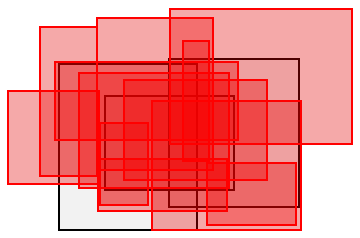 |
Ask for a specific property:
| In[19]:= | ![boxes = {
Rectangle[{3.241549223388991, 1.8258945791733319`}, {
10.659287859633295`, 10.773294493394275`}],
Rectangle[{0.4869914284730348, 4.321183643750274}, {5.369829888721986,
9.31386702637484}],
Rectangle[{2.2334201426158136`, 4.721638979849482}, {
5.291543408030995, 12.769601273219152`}],
Rectangle[{5.349846089859113, 2.8592299264608263`}, {
12.259520398084739`, 5.65464262378527}],
Rectangle[{5.419709227350725, 3.2032779499946393`}, {
8.019495864892848, 7.597470779871912}],
Rectangle[{2.9916342183590716`, 6.701712853508063}, {
12.82951197826295, 10.889573073474823`}],
Rectangle[{5.716124755621678, 4.016397691332317}, {
12.634485498683249`, 9.030579596384047}],
Rectangle[{4.318687518098674, 4.086673071150529}, {
12.377658857900416`, 10.295175285987018`}],
Rectangle[{5.254646844539921, 5.048321499467785}, {
11.505305608427992`, 13.227130047971752`}],
Rectangle[{8.231089286494171, 1.8404075028314466`}, {16.2229662869946,
8.789967125833199}],
Rectangle[{6.7403064092133205`, 4.533063177477215}, {
14.410877169797764`, 9.89745177054213}],
Rectangle[{9.862402933845159, 5.563175394985179}, {
11.276877537331307`, 11.97757563169206}],
Rectangle[{11.180782570286068`, 2.0918187606070013`}, {
15.93179551146674, 5.471116257515766}],
Rectangle[{9.160598972568872, 3.0721821586970166`}, {
16.105158304284622`, 11.003417304165653`}],
Rectangle[{9.199084080623214, 6.486880587531073}, {
18.967352233543956`, 13.733293159109362`}]};
scores = {0.18372941641066354`, 0.7792523485576668, 0.7552787064436872, 0.20397739818471128`, 0.29873901258951774`, 0.5385959520846411, 0.0019547594798015044`, 0.7158017739163653, 0.16959589408147346`, 0.8582668907417819, 0.21215626418505606`, 0.304448649385447, 0.33974292946852325`, 0.4268902847722864, 0.3182413575132059};
ResourceFunction["NonMaximumSuppression"][boxes -> scores, "Index"]](https://www.wolframcloud.com/obj/resourcesystem/images/1a4/1a4d3d13-f50c-4ae2-9c5f-860c451341c5/4343df4b6f24dbea.png) |
| Out[20]= |
The index is determined by the order of the scores for rectangles that contained in the result:
| In[21]:= |
| Out[21]= |
Ask for a list of properties:
| In[22]:= | ![boxes = {
Rectangle[{3.241549223388991, 1.8258945791733319`}, {
10.659287859633295`, 10.773294493394275`}],
Rectangle[{0.4869914284730348, 4.321183643750274}, {5.369829888721986,
9.31386702637484}],
Rectangle[{2.2334201426158136`, 4.721638979849482}, {
5.291543408030995, 12.769601273219152`}],
Rectangle[{5.349846089859113, 2.8592299264608263`}, {
12.259520398084739`, 5.65464262378527}],
Rectangle[{5.419709227350725, 3.2032779499946393`}, {
8.019495864892848, 7.597470779871912}],
Rectangle[{2.9916342183590716`, 6.701712853508063}, {
12.82951197826295, 10.889573073474823`}],
Rectangle[{5.716124755621678, 4.016397691332317}, {
12.634485498683249`, 9.030579596384047}],
Rectangle[{4.318687518098674, 4.086673071150529}, {
12.377658857900416`, 10.295175285987018`}],
Rectangle[{5.254646844539921, 5.048321499467785}, {
11.505305608427992`, 13.227130047971752`}],
Rectangle[{8.231089286494171, 1.8404075028314466`}, {16.2229662869946,
8.789967125833199}],
Rectangle[{6.7403064092133205`, 4.533063177477215}, {
14.410877169797764`, 9.89745177054213}],
Rectangle[{9.862402933845159, 5.563175394985179}, {
11.276877537331307`, 11.97757563169206}],
Rectangle[{11.180782570286068`, 2.0918187606070013`}, {
15.93179551146674, 5.471116257515766}],
Rectangle[{9.160598972568872, 3.0721821586970166`}, {
16.105158304284622`, 11.003417304165653`}],
Rectangle[{9.199084080623214, 6.486880587531073}, {
18.967352233543956`, 13.733293159109362`}]};
scores = {0.18372941641066354`, 0.7792523485576668, 0.7552787064436872, 0.20397739818471128`, 0.29873901258951774`, 0.5385959520846411, 0.0019547594798015044`, 0.7158017739163653, 0.16959589408147346`, 0.8582668907417819, 0.21215626418505606`, 0.304448649385447, 0.33974292946852325`, 0.4268902847722864, 0.3182413575132059};
ResourceFunction["NonMaximumSuppression"][
boxes -> scores, {"Index", "Region"}]](https://www.wolframcloud.com/obj/resourcesystem/images/1a4/1a4d3d13-f50c-4ae2-9c5f-860c451341c5/3fc24080d1e79e6a.png) |
| Out[24]= |  |
Ask for all properties:
| In[25]:= |
| Out[25]= |  |
Specify an AcceptanceThreshold for the regions:
| In[26]:= | ![boxes = {
Rectangle[{3.241549223388991, 1.8258945791733319`}, {
10.659287859633295`, 10.773294493394275`}],
Rectangle[{0.4869914284730348, 4.321183643750274}, {5.369829888721986,
9.31386702637484}],
Rectangle[{2.2334201426158136`, 4.721638979849482}, {
5.291543408030995, 12.769601273219152`}],
Rectangle[{5.349846089859113, 2.8592299264608263`}, {
12.259520398084739`, 5.65464262378527}],
Rectangle[{5.419709227350725, 3.2032779499946393`}, {
8.019495864892848, 7.597470779871912}],
Rectangle[{2.9916342183590716`, 6.701712853508063}, {
12.82951197826295, 10.889573073474823`}],
Rectangle[{5.716124755621678, 4.016397691332317}, {
12.634485498683249`, 9.030579596384047}],
Rectangle[{4.318687518098674, 4.086673071150529}, {
12.377658857900416`, 10.295175285987018`}],
Rectangle[{5.254646844539921, 5.048321499467785}, {
11.505305608427992`, 13.227130047971752`}],
Rectangle[{8.231089286494171, 1.8404075028314466`}, {16.2229662869946,
8.789967125833199}],
Rectangle[{6.7403064092133205`, 4.533063177477215}, {
14.410877169797764`, 9.89745177054213}],
Rectangle[{9.862402933845159, 5.563175394985179}, {
11.276877537331307`, 11.97757563169206}],
Rectangle[{11.180782570286068`, 2.0918187606070013`}, {
15.93179551146674, 5.471116257515766}],
Rectangle[{9.160598972568872, 3.0721821586970166`}, {
16.105158304284622`, 11.003417304165653`}],
Rectangle[{9.199084080623214, 6.486880587531073}, {
18.967352233543956`, 13.733293159109362`}]};
scores = {0.18372941641066354`, 0.7792523485576668, 0.7552787064436872, 0.20397739818471128`, 0.29873901258951774`, 0.5385959520846411, 0.0019547594798015044`, 0.7158017739163653, 0.16959589408147346`, 0.8582668907417819, 0.21215626418505606`, 0.304448649385447, 0.33974292946852325`, 0.4268902847722864, 0.3182413575132059};
ResourceFunction["NonMaximumSuppression"][boxes -> scores, AcceptanceThreshold -> .5]](https://www.wolframcloud.com/obj/resourcesystem/images/1a4/1a4d3d13-f50c-4ae2-9c5f-860c451341c5/60f033aba99047ca.png) |
| Out[27]= |  |
| In[28]:= |
| Out[28]= | 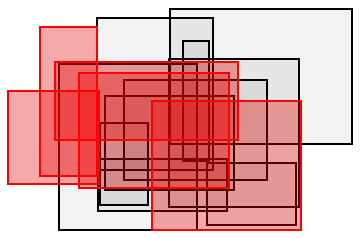 |
Use MaxOverlapFraction→f to only keep regions with an overlap smaller than f:
| In[29]:= | ![boxes = {
Rectangle[{3.241549223388991, 1.8258945791733319`}, {
10.659287859633295`, 10.773294493394275`}],
Rectangle[{0.4869914284730348, 4.321183643750274}, {5.369829888721986,
9.31386702637484}],
Rectangle[{2.2334201426158136`, 4.721638979849482}, {
5.291543408030995, 12.769601273219152`}],
Rectangle[{5.349846089859113, 2.8592299264608263`}, {
12.259520398084739`, 5.65464262378527}],
Rectangle[{5.419709227350725, 3.2032779499946393`}, {
8.019495864892848, 7.597470779871912}],
Rectangle[{2.9916342183590716`, 6.701712853508063}, {
12.82951197826295, 10.889573073474823`}],
Rectangle[{5.716124755621678, 4.016397691332317}, {
12.634485498683249`, 9.030579596384047}],
Rectangle[{4.318687518098674, 4.086673071150529}, {
12.377658857900416`, 10.295175285987018`}],
Rectangle[{5.254646844539921, 5.048321499467785}, {
11.505305608427992`, 13.227130047971752`}],
Rectangle[{8.231089286494171, 1.8404075028314466`}, {16.2229662869946,
8.789967125833199}],
Rectangle[{6.7403064092133205`, 4.533063177477215}, {
14.410877169797764`, 9.89745177054213}],
Rectangle[{9.862402933845159, 5.563175394985179}, {
11.276877537331307`, 11.97757563169206}],
Rectangle[{11.180782570286068`, 2.0918187606070013`}, {
15.93179551146674, 5.471116257515766}],
Rectangle[{9.160598972568872, 3.0721821586970166`}, {
16.105158304284622`, 11.003417304165653`}],
Rectangle[{9.199084080623214, 6.486880587531073}, {
18.967352233543956`, 13.733293159109362`}]};
scores = {0.18372941641066354`, 0.7792523485576668, 0.7552787064436872, 0.20397739818471128`, 0.29873901258951774`, 0.5385959520846411, 0.0019547594798015044`, 0.7158017739163653, 0.16959589408147346`, 0.8582668907417819, 0.21215626418505606`, 0.304448649385447, 0.33974292946852325`, 0.4268902847722864, 0.3182413575132059};
ResourceFunction["NonMaximumSuppression"][boxes -> scores] // Length](https://www.wolframcloud.com/obj/resourcesystem/images/1a4/1a4d3d13-f50c-4ae2-9c5f-860c451341c5/38dab9a71ebbe9a9.png) |
| Out[30]= |
| In[31]:= |
| Out[31]= |
If soft NMS is used, MaxOverlapFraction is used to defined the scaling behaviour:
| In[32]:= | ![boxes = {
Rectangle[{3.241549223388991, 1.8258945791733319`}, {
10.659287859633295`, 10.773294493394275`}],
Rectangle[{0.4869914284730348, 4.321183643750274}, {5.369829888721986,
9.31386702637484}],
Rectangle[{2.2334201426158136`, 4.721638979849482}, {
5.291543408030995, 12.769601273219152`}],
Rectangle[{5.349846089859113, 2.8592299264608263`}, {
12.259520398084739`, 5.65464262378527}],
Rectangle[{5.419709227350725, 3.2032779499946393`}, {
8.019495864892848, 7.597470779871912}],
Rectangle[{2.9916342183590716`, 6.701712853508063}, {
12.82951197826295, 10.889573073474823`}],
Rectangle[{5.716124755621678, 4.016397691332317}, {
12.634485498683249`, 9.030579596384047}],
Rectangle[{4.318687518098674, 4.086673071150529}, {
12.377658857900416`, 10.295175285987018`}],
Rectangle[{5.254646844539921, 5.048321499467785}, {
11.505305608427992`, 13.227130047971752`}],
Rectangle[{8.231089286494171, 1.8404075028314466`}, {16.2229662869946,
8.789967125833199}],
Rectangle[{6.7403064092133205`, 4.533063177477215}, {
14.410877169797764`, 9.89745177054213}],
Rectangle[{9.862402933845159, 5.563175394985179}, {
11.276877537331307`, 11.97757563169206}],
Rectangle[{11.180782570286068`, 2.0918187606070013`}, {
15.93179551146674, 5.471116257515766}],
Rectangle[{9.160598972568872, 3.0721821586970166`}, {
16.105158304284622`, 11.003417304165653`}],
Rectangle[{9.199084080623214, 6.486880587531073}, {
18.967352233543956`, 13.733293159109362`}]};
scores = {0.18372941641066354`, 0.7792523485576668, 0.7552787064436872, 0.20397739818471128`, 0.29873901258951774`, 0.5385959520846411, 0.0019547594798015044`, 0.7158017739163653, 0.16959589408147346`, 0.8582668907417819, 0.21215626418505606`, 0.304448649385447, 0.33974292946852325`, 0.4268902847722864, 0.3182413575132059};
ResourceFunction["NonMaximumSuppression"][boxes -> scores, MaxOverlapFraction -> 0, Method -> "Soft"] // Length](https://www.wolframcloud.com/obj/resourcesystem/images/1a4/1a4d3d13-f50c-4ae2-9c5f-860c451341c5/00e2ae63096ffeac.png) |
| Out[34]= |
If the a scaling value is given explicitly, the option is ignored:
| In[35]:= |
| Out[35]= |
By default, regions are removed using a hard overlap threshold:
| In[36]:= | ![boxes = {
Rectangle[{3.241549223388991, 1.8258945791733319`}, {
10.659287859633295`, 10.773294493394275`}],
Rectangle[{0.4869914284730348, 4.321183643750274}, {5.369829888721986,
9.31386702637484}],
Rectangle[{2.2334201426158136`, 4.721638979849482}, {
5.291543408030995, 12.769601273219152`}],
Rectangle[{5.349846089859113, 2.8592299264608263`}, {
12.259520398084739`, 5.65464262378527}],
Rectangle[{5.419709227350725, 3.2032779499946393`}, {
8.019495864892848, 7.597470779871912}],
Rectangle[{2.9916342183590716`, 6.701712853508063}, {
12.82951197826295, 10.889573073474823`}],
Rectangle[{5.716124755621678, 4.016397691332317}, {
12.634485498683249`, 9.030579596384047}],
Rectangle[{4.318687518098674, 4.086673071150529}, {
12.377658857900416`, 10.295175285987018`}],
Rectangle[{5.254646844539921, 5.048321499467785}, {
11.505305608427992`, 13.227130047971752`}],
Rectangle[{8.231089286494171, 1.8404075028314466`}, {16.2229662869946,
8.789967125833199}],
Rectangle[{6.7403064092133205`, 4.533063177477215}, {
14.410877169797764`, 9.89745177054213}],
Rectangle[{9.862402933845159, 5.563175394985179}, {
11.276877537331307`, 11.97757563169206}],
Rectangle[{11.180782570286068`, 2.0918187606070013`}, {
15.93179551146674, 5.471116257515766}],
Rectangle[{9.160598972568872, 3.0721821586970166`}, {
16.105158304284622`, 11.003417304165653`}],
Rectangle[{9.199084080623214, 6.486880587531073}, {
18.967352233543956`, 13.733293159109362`}]};
scores = {0.18372941641066354`, 0.7792523485576668, 0.7552787064436872, 0.20397739818471128`, 0.29873901258951774`, 0.5385959520846411, 0.0019547594798015044`, 0.7158017739163653, 0.16959589408147346`, 0.8582668907417819, 0.21215626418505606`, 0.304448649385447, 0.33974292946852325`, 0.4268902847722864, 0.3182413575132059};
result = ResourceFunction["NonMaximumSuppression"][boxes -> scores]](https://www.wolframcloud.com/obj/resourcesystem/images/1a4/1a4d3d13-f50c-4ae2-9c5f-860c451341c5/0b14be3b7144cc63.png) |
| Out[37]= |  |
| In[38]:= |
| Out[38]= | 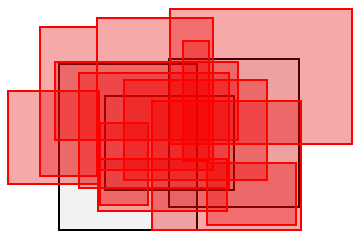 |
Filter boxes using a soft NMS that scales the weights based on the overlap:
| In[39]:= | ![ResourceFunction["NonMaximumSuppression"][boxes -> scores, Method -> "Soft"];
Graphics[{Opacity[0.05], EdgeForm[Black], boxes, Opacity[0.3], Red, EdgeForm[Red], %}, ImageSize -> Small]](https://www.wolframcloud.com/obj/resourcesystem/images/1a4/1a4d3d13-f50c-4ae2-9c5f-860c451341c5/67d1c60774fe27d6.png) |
| Out[40]= | 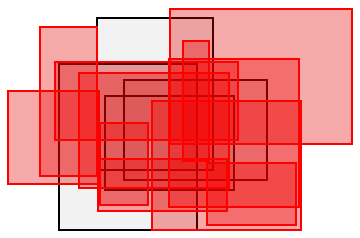 |
Specify the scaling value used to update the regions weights:
| In[41]:= | ![ResourceFunction["NonMaximumSuppression"][boxes -> scores, Method -> {"Soft", .05}];
Graphics[{Opacity[0.05], EdgeForm[Black], boxes, Opacity[0.3], Red, EdgeForm[Red], %}, ImageSize -> Small]](https://www.wolframcloud.com/obj/resourcesystem/images/1a4/1a4d3d13-f50c-4ae2-9c5f-860c451341c5/24592b8afe6e37a2.png) |
| Out[42]= | 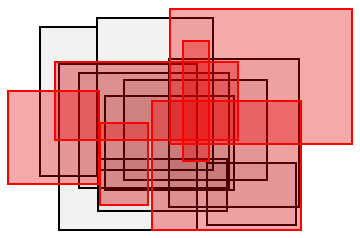 |
Soft NMS can become very slow if boxes are not removed:
| In[43]:= |
| In[44]:= |
| Out[44]= |
| In[45]:= |
| Out[45]= |
Even a small threshold can significantly speed-up the computation:
| In[46]:= |
| Out[46]= |
Wolfram Language 13.0 (December 2021) or above
This work is licensed under a Creative Commons Attribution 4.0 International License